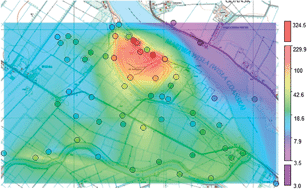A study on lead (210Pb) and polonium (210Po) contamination from phosphogypsum in the environment of Wiślinka (northern Poland)
Abstract
The results of polonium (210Po) and lead (210Pb) determination in different environmental soil samples collected in the vicinity of the phosphogypsum stack in Wiślinka (northern Poland) are presented and discussed in this paper. The 210Po and 210Pb concentrations in soil samples from the phosphogypsum stack recorded in this study are significantly higher only in areas that are close to the heap. The relationship between atmospheric deposition and elevated analyzed radionuclides concentrations in top soil layers, especially in the vicinity of the phosphogypsum stack, was showed in this study. 210Po and 210Pb radionuclides were detected in concentrations which could have harmful effects on human health or the environment. The considerably high concentrations of 210Po and 210Pb in soil samples collected from the vicinity of the phosphogypsum stack obtained in this study can lead to the conclusion that the presently undertaken recultivation process is successful and the 300 m2 protection zone around the phosphogypsum stack seems to be able to offset the negative influence of the phosphogypsum stack on the surrounding environment.


 Please wait while we load your content...
Please wait while we load your content...